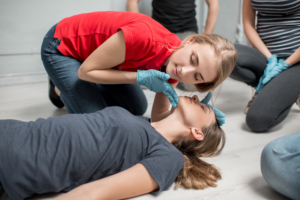Adult First Aid & CPR: Essential Knowledge for Caregivers
Ensuring the safety and well-being of adults in emergencies is crucial. Here’s a detailed breakdown of essential skills for handling various emergencies, based on the Canadian Red Cross Comprehensive Guide for First Aid and CPR.
Emergency Response
Quickly assess the situation to ensure safety. If the person is unresponsive or not breathing, call emergency services immediately. This initial assessment is crucial to determine the appropriate response and ensure both your safety and that of the injured person.
Performing CPR for Adults
CPR is needed if the person is unresponsive and not breathing normally. Here are the steps to follow:
- Check for Responsiveness: Gently tap and shout to see if they respond.
- Positioning: Place the person on a firm, flat surface.
- Chest Compressions: Compress about 2 inches deep at 100-120 compressions per minute.
- Rescue Breaths: After 30 compressions, tilt the head back, pinch the nose, cover the mouth, and give 2 breaths.
- Continue CPR: Keep going until signs of life or help arrives.
Managing Choking
Recognizing choking is crucial if a person cannot cry, cough, or breathe. Here’s what to do:
- Assess the Situation: Confirm they are choking by looking for signs like inability to speak or breathe.

- Back Blows: Stand behind and give up to 5 back blows between the shoulder blades.
- Abdominal Thrusts: If back blows don’t work, give up to 5 abdominal thrusts (Heimlich maneuver).
- Alternate Methods: Continue until the object is dislodged or they become unresponsive. If unresponsive, start CPR and call for help.
Managing Wounds and Burns
Knowing when and how to treat different types of wounds and burns is essential.
- Minor Cuts: Clean the area with water, apply antibiotic ointment, and cover with a sterile bandage.
- Severe Bleeding: Apply firm pressure with a clean cloth or bandage to control bleeding and seek medical help immediately.
- Minor Burns: Cool under running water for at least 10 minutes, then cover with a sterile, non-stick dressing.
- Severe Burns: Do not remove any clothing stuck to the burn. Cover the burn with a clean cloth and seek emergency medical assistance.
Recognizing and Responding to Common Illnesses
- Heart Attack: Recognize symptoms like chest pain, shortness of breath, and nausea. Call emergency services immediately and provide aspirin if not allergic.
- Stroke: Use FAST (Face drooping, Arm weakness, Speech difficulties, Time to call 911) to identify stroke symptoms.
- Diabetic Emergencies: For low blood sugar, give 15-20 grams of fast-acting sugar like juice or glucose tablets. For high blood sugar, seek medical help if the person can’t manage it themselves.
- Seizures: Move objects away to prevent injury, do not restrain, and time the seizure. After it ends, check for injuries and place the person in the recovery position if unresponsive but breathing.
- Angina: Recognize symptoms similar to a heart attack. Help the person take their prescribed medication, such as nitroglycerin, and call for emergency help if the pain does not subside.
- Shock: Lay the person down, elevate their legs, keep them warm with a blanket, and reassure them until help arrives.
Managing Environmental Injuries
- Heat-Related Illnesses: Move the person to a cooler place, give them sips of water, and apply cool, wet cloths to help reduce body temperature.
- Cold-Related Illnesses: Move the person to a warmer place, remove any wet clothing, and wrap them in blankets to slowly raise their body temperature.
Dealing with Poisoning and WHMIS
In cases of poisoning, quick identification and appropriate response are critical.
- Identify the Poison: Try to determine what the person has ingested by checking labels or asking questions.
- Do Not Induce Vomiting: Unless advised by a poison control center or medical professional.
- Call Poison Control: Seek immediate advice and follow their instructions.
The Workplace Hazardous Materials Information System (WHMIS) is essential for understanding how to handle chemicals safely. Familiarize yourself with WHMIS labels and Safety Data Sheets (SDS) to ensure proper response to poisoning incidents involving hazardous materials.
Conclusion
Knowing how to perform first aid and CPR for adults can save lives. Stay informed and prepared to provide crucial support in emergencies. For more detailed information, refer to the Canadian Red Cross Comprehensive Guide for First Aid and CPR.
Get certified in adult first aid and CPR with Alert First Aid. Register for a course today to ensure the safety of adults in your care.



